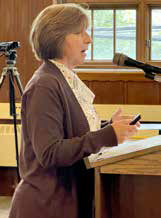Study session yields many questions, few answers; study group may form to look into recommendation for hospital ownership
An “ambulance summit” in Ely yielded an array of responses to a recommendation that local service go back under the umbrella of Ely-Bloomenson Community Hospital.
Key stakeholders voiced everything from skepticism to enthusiasm about a plan that went public two months ago - but has gained little traction since.
But some movement may be on the horizon after the study session convened Tuesday by Ely’s city council with representatives of area governments, the hospital, neighboring communities and the non-profit that now controls Ely’s ambulance service all at City Hall.
Ely leaders pressed for the formation of a working group that will look to perhaps advance the concept, and seek to answer questions that have arisen, both during discussion this week and since the idea went public in mid-June.
“The devil is in the details,” said Ely council member Paul Kess. “And (hospital administrator Patti Banks) can’t answer many of those details because they don’t exist yet. It is our intention to want to explore what a cooperative arrangement might look like, we should work together to find the funding to get those answers.”
At issue is a recommendation from SafeTech Solutions, a firm engaged by the hospital and with vast experience in emergency management, that EBCH take on ambulance service not only in Ely, but in the Babbitt and Tower areas as well.
The firm suggested that EBCH’s standing as a critical access hospital would help the ambulance service capture a much larger share of Medicare reimbursements and fund an operation that would allow for as many as four fully-staffed ambulances in the region - two in Ely and one each in Babbitt and Tower.
But while the city of Winton has already gone on record in support of the proposal and Tower and Ely representatives have indicated they’re open to pursuing more details, the plan encountered pushback during the hour-plus session in Ely.
Babbitt council member Glenn Anderson raised a series of concerns related to staffing, coverage and facilities, while former Ely Mayor Chuck Novak pressed for local officials to slow down.
Novak, a board member for the Ely Area Ambulance Service, the non-profit that runs Ely’s ambulance operation, charged “there’s too many questions and not enough answers.”

Novak argued that the plan to have four total ambulances marked “a reduction in capability” in comparison to the current operations.
Novak also pointed to the statewide challenge and subsequent discussions related to rural ambulance service and warned “nothing has been decided” at the state level.
“Don’t throw caution to the wind,” said Novak. “We need to take baby steps with this and not jump in and make any rash decisions.”
The meeting started with a presentation by Banks and a review of the recommendations advanced by SafeTech.
Banks conceded “I don’t have all the answers,” and that some of the current projections related to how a hospital-operated ambulance service might look are “purely speculative” and “subject to change.”
Yet Banks also reiterated many of the challenges related to the current set-up, which have included recent difficulties encountered by the EAAS. Those have included budget shortfalls requiring an infusion of cash from local governments, staffing issues particularly related to interfacility transports.
Banks said that patient satisfaction surveys and concerns raised by physicians have prompted the hospital to consider returning to an ownership model that EBCH abandoned in the mid-2000s.
Banks told an audience of about 50 people that the model advanced by SafeTech “is more sustainable and future looking,” but cautioned that change must come with community support.
“The hospital can not just take over (the ambulance),” she said.
Banks also walked back a previous statement that a hospital-owned ambulance would require a public subsidy of $45 to $55 per capita, more than three times the current subsidy of $15.15 per capita that local governments are set to provide the EAAS next year.
“That was me just throwing something at a dartboard,” said Banks.
Ely council member Al Forsman, who suggested the study session as a way to bring the parties back together, said that quality of service isn’t an issue.
“We know we have top quality ambulance personnel out there,” said Forsman. “The question is, can we keep this working and doing the service they need to provide for the community?”
Forsman posed the question “are we going to let this drop or are we going to move forward with this?”
Responses clearly varied, with Tower ambulance representative Dena Suihkonen noting four ambulance calls in her community the day before and questioning how that might have been handled under the new model.
“Tower handled all four of the calls,” Suihkonen said. “We have people who show up when the chips are down.”
Anderson, representing Babbitt, raised a series of questions, including “who’s going to supply our ambulance? We have two ambulances and now Ely is going to take that over and we’re going to have one ambulance. Are you going to buy our ambulances that we have?”
Banks responded that it’s not clear the level of government support that might be required but added “the goal is to keep an ambulance in each community.”
Responding to questions about the level of service and staffing, Banks acknowledged the uncertainties but reiterated that should the model move forward as proposed that “this would be hospital’s responsibility to staff and employ. If that is the level that we are committing to to start out with then that is the level we will have to achieve.”
Banks suggested that some form of joint powers agreement may be required if EBCH takes on licensing and develops a relationship with local governments.
Morse supervisor Bob Berrini pointed back two decades to when EBCH asked local entities to step up and support the service, and pointed to advances the EAAS has made particularly with equipment.
Also uncertain is the future of the building that now serves as home to the EAAS.
But amid the questions came support for change.
Rob Wilmunen, a board member at EBCH, pointed to challenges most notably the inability of EAAS to handle up to 11 percent of transport requests.
“Eleven percent had to take themselves or have a family member drive them to a higher level of care,” said Wilmunen. “That’s not even counting the people who had to wait three hours.”
He also pointed to the experience and background of SafeTech Solutions.
“This was the model they came up with,” said Wilmunen.
Matt Tuchel of Breitung Township said the issue came down to economies of scale and compared a potential alliance to school and sports team mergers.
“This is do-able,” said Tuchel. “This is something we need to work toward I think.”
Tuchel also said the hospital is a natural fit to take on the service.
“The advantage the hospital brings is quality,” said Tuchel.










